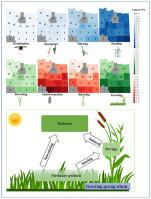当前位置:
X-MOL 学术
›
Environ. Pollut.
›
论文详情
Our official English website, www.x-mol.net, welcomes your
feedback! (Note: you will need to create a separate account there.)
Assessing the regional biogenic methanol emission from spring wheat during the growing season: A Canadian case study
Environmental Pollution ( IF 7.6 ) Pub Date : 2021-06-22 , DOI: 10.1016/j.envpol.2021.117602 Mengfan Cai 1 , Chunjiang An 1 , Christophe Guy 2 , Chen Lu 3 , Fereshteh Mafakheri 4
Environmental Pollution ( IF 7.6 ) Pub Date : 2021-06-22 , DOI: 10.1016/j.envpol.2021.117602 Mengfan Cai 1 , Chunjiang An 1 , Christophe Guy 2 , Chen Lu 3 , Fereshteh Mafakheri 4
Affiliation

|
As a volatile organic compound existing in the atmosphere, methanol plays a key role in atmospheric chemistry due to its comparatively high abundance and long lifetime. Croplands are a significant source of biogenic methanol, but there is a lack of systematic assessment for the production and emission of methanol from crops in various phases. In this study, methanol emissions from spring wheat during the growing period were estimated using a developed emission model. The temporal and spatial variations of methanol emissions of spring wheat in a Canadian province were investigated. The averaged methanol emission of spring wheat is found to be 37.94 ± 7.5 μg·m·h, increasing from north to south and exhibiting phenological peak to valley characteristics. Moreover, cold crop districts are projected to be with higher increase in air temperature and consequent methanol emissions during 2020–2099. Furthermore, the seasonality of methanol emissions is found to be positively correlated to concentrations of CO, filterable particulate matter, and PM but negatively related to NO and O. The uncertainty and sensitivity analysis results suggest that methanol emissions show a Gamma probabilistic distribution, and growth length, air temperature, solar radiation and leafage are the most important influencing variables. In most cases, methanol emissions increase with air temperature in the range of 3–35 °C while the excessive temperature may result in decreased methanol emissions because of inactivated enzyme activity or increased instant methanol emissions due to heat injury. Notably, induced emission might be the major source of biogenic methanol of mature leaves. The results of this study can be used to develop appropriate strategies for regional emission management of cropping systems.
中文翻译:

评估生长季节春小麦的区域生物甲醇排放:加拿大案例研究
甲醇作为大气中存在的挥发性有机化合物,因其丰度较高、寿命较长,在大气化学中发挥着关键作用。农田是生物甲醇的重要来源,但缺乏对农作物不同阶段甲醇生产和排放的系统评估。在本研究中,使用开发的排放模型估算了春小麦在生长期间的甲醇排放量。研究了加拿大某省春小麦甲醇排放的时空变化。春小麦平均甲醇排放量为37.94±7.5 μg·m·h,自北向南逐渐增加,并呈现出物候峰谷特征。此外,预计 2020 年至 2099 年期间,冷作作物区的气温和甲醇排放量将大幅上升。此外,甲醇排放的季节性与CO、可过滤颗粒物和PM的浓度呈正相关,但与NO和O的浓度呈负相关。不确定性和敏感性分析结果表明,甲醇排放呈现Gamma概率分布,并且呈增长趋势。长度、气温、太阳辐射和树叶是最重要的影响变量。在大多数情况下,甲醇排放量随着气温在3-35°C范围内而增加,而过高的温度可能会因酶活性失活而导致甲醇排放量减少,或因热损伤而导致甲醇即时排放量增加。值得注意的是,诱导排放可能是成熟叶子生物源甲醇的主要来源。这项研究的结果可用于制定适当的耕作系统区域排放管理策略。
更新日期:2021-06-22
中文翻译:

评估生长季节春小麦的区域生物甲醇排放:加拿大案例研究
甲醇作为大气中存在的挥发性有机化合物,因其丰度较高、寿命较长,在大气化学中发挥着关键作用。农田是生物甲醇的重要来源,但缺乏对农作物不同阶段甲醇生产和排放的系统评估。在本研究中,使用开发的排放模型估算了春小麦在生长期间的甲醇排放量。研究了加拿大某省春小麦甲醇排放的时空变化。春小麦平均甲醇排放量为37.94±7.5 μg·m·h,自北向南逐渐增加,并呈现出物候峰谷特征。此外,预计 2020 年至 2099 年期间,冷作作物区的气温和甲醇排放量将大幅上升。此外,甲醇排放的季节性与CO、可过滤颗粒物和PM的浓度呈正相关,但与NO和O的浓度呈负相关。不确定性和敏感性分析结果表明,甲醇排放呈现Gamma概率分布,并且呈增长趋势。长度、气温、太阳辐射和树叶是最重要的影响变量。在大多数情况下,甲醇排放量随着气温在3-35°C范围内而增加,而过高的温度可能会因酶活性失活而导致甲醇排放量减少,或因热损伤而导致甲醇即时排放量增加。值得注意的是,诱导排放可能是成熟叶子生物源甲醇的主要来源。这项研究的结果可用于制定适当的耕作系统区域排放管理策略。











































 京公网安备 11010802027423号
京公网安备 11010802027423号